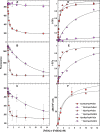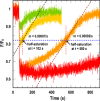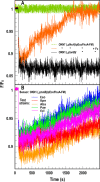Universal fluorescent sensors of high-affinity iron transport, applied to ESKAPE pathogens
- PMID: 30679312
- PMCID: PMC6433069
- DOI: 10.1074/jbc.RA118.006921
Universal fluorescent sensors of high-affinity iron transport, applied to ESKAPE pathogens
Abstract
Sensitive assays of biochemical specificity, affinity, and capacity are valuable both for basic research and drug discovery. We created fluorescent sensors that monitor high-affinity binding reactions and used them to study iron acquisition by ESKAPE bacteria, which are frequently responsible for antibiotic-resistant infections. By introducing site-directed Cys residues in bacterial iron transporters and modifying them with maleimide fluorophores, we generated living cells or purified proteins that bind but do not transport target compounds. These constructs sensitively detected ligand concentrations in solution, enabling accurate, real-time spectroscopic analysis of membrane transport by other cells. We assessed the efficacy of these "fluorescent decoy" (FD) sensors by characterizing active iron transport in the ESKAPE bacteria. The FD sensors monitored uptake of both ferric siderophores and hemin by the pathogens. An FD sensor for a particular ligand was universally effective in observing the uptake of that compound by all organisms we tested. We adapted the FD sensors to microtiter format, where they allow high-throughput screens for chemicals that block iron uptake, without genetic manipulations of the virulent target organisms. Hence, screening assays with FD sensors facilitate studies of mechanistic biochemistry, as well as discovery of chemicals that inhibit prokaryotic membrane transport. With appropriate design, FD sensors are potentially applicable to any pro- or eukaryotic high-affinity ligand transport process.
Keywords: ESKAPE pathogen; fluorescence; heme; iron; ligand-binding protein; membrane transport; pathogenesis; siderophore; spectroscopy.
© 2019 Chakravorty et al.
Conflict of interest statement
The authors declare that they have no conflicts of interest with the contents of this article
Figures







Similar articles
-
Fluorescence High-Throughput Screening for Inhibitors of TonB Action.J Bacteriol. 2017 Apr 25;199(10):e00889-16. doi: 10.1128/JB.00889-16. Print 2017 May 15. J Bacteriol. 2017. PMID: 28242720 Free PMC article.
-
High-Throughput Screening Assay for Inhibitors of TonB-Dependent Iron Transport.J Biomol Screen. 2016 Mar;21(3):316-22. doi: 10.1177/1087057115613788. Epub 2015 Oct 30. J Biomol Screen. 2016. PMID: 26518031
-
TonB-Dependent Heme/Hemoglobin Utilization by Caulobacter crescentus HutA.J Bacteriol. 2017 Feb 28;199(6):e00723-16. doi: 10.1128/JB.00723-16. Print 2017 Mar 15. J Bacteriol. 2017. PMID: 28031282 Free PMC article.
-
Recent insights into iron import by bacteria.Curr Opin Chem Biol. 2011 Apr;15(2):328-34. doi: 10.1016/j.cbpa.2011.01.005. Epub 2011 Feb 1. Curr Opin Chem Biol. 2011. PMID: 21277822 Review.
-
Iron uptake mechanisms as key virulence factors in bacterial fish pathogens.J Appl Microbiol. 2020 Jul;129(1):104-115. doi: 10.1111/jam.14595. Epub 2020 Feb 12. J Appl Microbiol. 2020. PMID: 31994331 Review.
Cited by
-
Iron Acquisition Systems of Gram-negative Bacterial Pathogens Define TonB-Dependent Pathways to Novel Antibiotics.Chem Rev. 2021 May 12;121(9):5193-5239. doi: 10.1021/acs.chemrev.0c01005. Epub 2021 Mar 16. Chem Rev. 2021. PMID: 33724814 Free PMC article. Review.
-
Siderophore-mediated iron acquisition by Klebsiella pneumoniae.J Bacteriol. 2024 May 23;206(5):e0002424. doi: 10.1128/jb.00024-24. Epub 2024 Apr 9. J Bacteriol. 2024. PMID: 38591913 Free PMC article.
-
Pseudomonas aeruginosa FpvB Is a High-Affinity Transporter for Xenosiderophores Ferrichrome and Ferrioxamine B.mBio. 2023 Feb 28;14(1):e0314922. doi: 10.1128/mbio.03149-22. Epub 2022 Dec 12. mBio. 2023. PMID: 36507834 Free PMC article.
-
Specificity and mechanism of TonB-dependent ferric catecholate uptake by Fiu.Front Microbiol. 2024 Mar 27;15:1355253. doi: 10.3389/fmicb.2024.1355253. eCollection 2024. Front Microbiol. 2024. PMID: 38601941 Free PMC article.
-
Fluorescent Binding Protein Sensors for Detection and Quantification of Biochemicals, Metabolites, and Natural Products.Bio Protoc. 2022 Nov 20;12(22):e4543. doi: 10.21769/BioProtoc.4543. eCollection 2022 Nov 20. Bio Protoc. 2022. PMID: 36532683 Free PMC article.
References
-
- Tacconelli E., and Magrini N. (2017) Global Priority List of Antibiotic-resistant Bacteria to Guide Research, Discovery, and Development of New Antibiotics, World Health Organization, Geneva
Publication types
MeSH terms
Substances
Associated data
- Actions
Grants and funding
LinkOut - more resources
Full Text Sources
Medical

